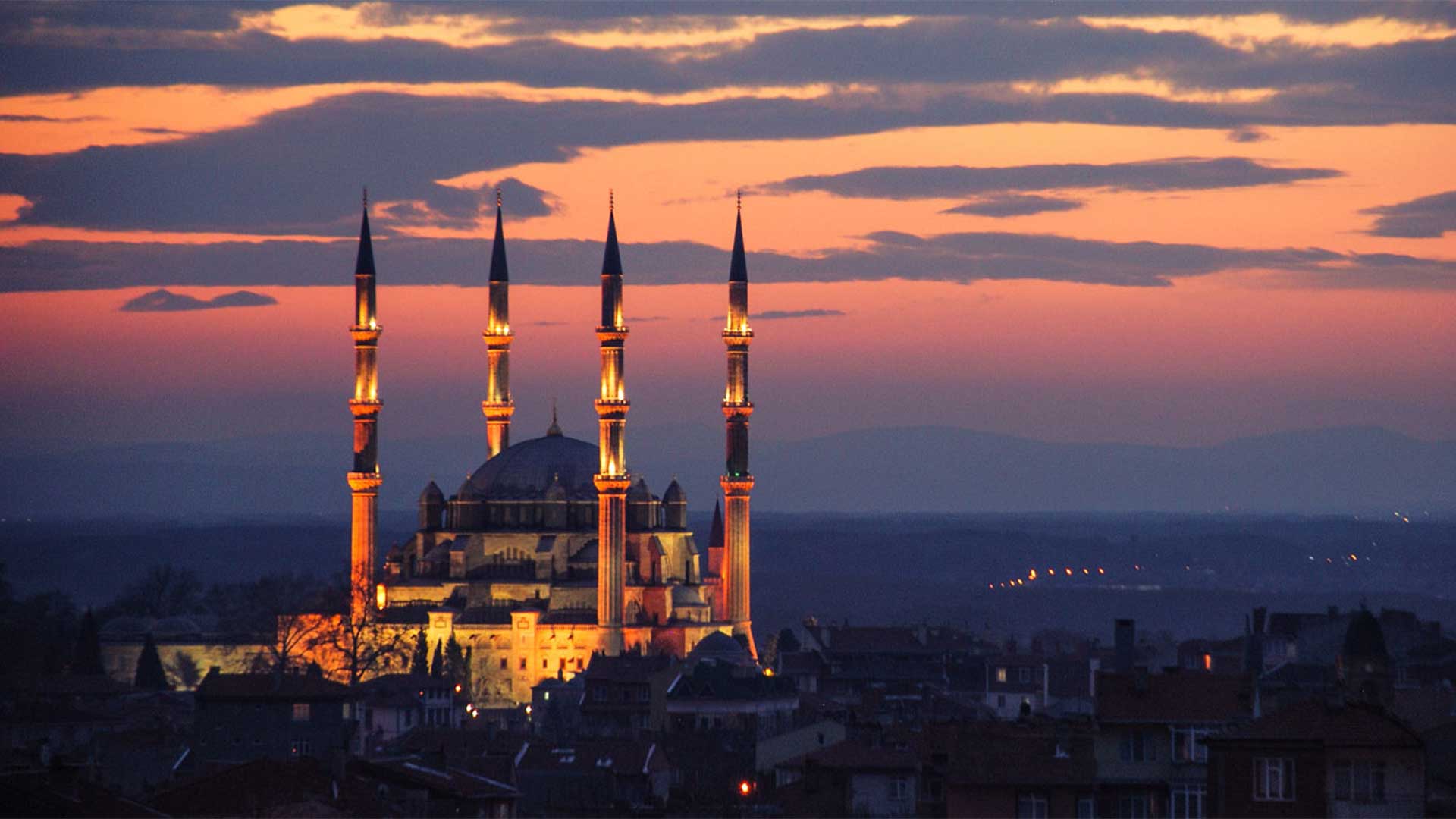
In the city of Edirne, Turkey, stands an architectural marvel. The Selimiye Mosque Turkey, a masterpiece of Ottoman architecture, is a sight to behold.
Commissioned by Sultan Selim II, it was completed in 1575. The mosque’s design is the work of Mimar Sinan, the imperial architect. He considered the Selimiye Mosque his crowning achievement.
The mosque’s grand dome is a notable feature. It measures 31.25 meters in diameter and stands at a height of 43.28 meters. This dome is supported by eight massive pillars, creating an open and airy interior.
Four slender minarets reach skyward from the mosque. At 83 meters, they are among the tallest in the world. These minarets are said to represent the four caliphs of Islam.
Inside, the mosque is adorned with intricate Iznik tiles. The prayer hall is lit by 249 windows, allowing natural light to play a significant role in the interior ambiance. The mihrab and minbar are finely decorated, showcasing the exquisite Ottoman woodwork.
The mosque complex includes a madrasa, a library, and a hospital. These structures served as centers of learning and healing in the Ottoman Empire. The mosque’s courtyard is spacious, featuring a fountain for ablutions.
The Selimiye Mosque is part of the Historic Areas of Istanbul, a UNESCO World Heritage Site. Its design reflects the zenith of Islamic art and architecture. The mosque’s influence on Ottoman architecture is significant.
Today, the mosque remains an active place of worship. It is also a popular tourist destination and a site of pilgrimage. Visitors often experience a sense of awe and spirituality upon entering.
In this article, we will explore the historical and architectural significance of the Selimiye Mosque. We will delve into its unique features and serve as a guide for those planning to visit. Join us as we journey through the grandeur of this architectural marvel.
Table of Contents
- The Historical Significance of Selimiye Mosque
- Architectural Genius of Mimar Sinan
- The Grand Design of Selimiye Mosque
- The Mosque’s Social Complex: A Hub of Ottoman Life
- Selimiye Mosque as a UNESCO World Heritage Site
- The Influence of Selimiye Mosque on Ottoman Architecture
- Visiting Selimiye Mosque: A Traveler’s Guide
- Conclusion: The Enduring Legacy of Selimiye Mosque
- FAQs
The Historical Significance of Selimiye Mosque
The Selimiye Mosque is not only an architectural wonder but also a rich historical monument. Its creation marked an era of cultural and political significance for the Ottoman Empire. Situated in Edirne, a former capital of the Ottoman Empire, the mosque stands as a testament to the empire’s golden age.
Sultan Selim II, for whom the mosque is named, commissioned its construction. His reign represented a period of peace and expansion in the empire. The mosque was a symbol of imperial power and religious fervor, embodying Selim II’s ambition.
The choice of Edirne as the mosque’s location was deliberate. The city, with its rich history, was strategically significant, bridging Europe and Asia. Edirne’s prominence made it an ideal site for an architectural showcase.
Mimar Sinan, the chief Ottoman architect, was entrusted with the task. Known for his exceptional skills, Sinan’s work on the mosque was to define his legacy. He declared Selimiye as his masterpiece, surpassing his earlier works in Istanbul.

The mosque’s construction between 1568 and 1575 demanded the empire’s best talents. Craftsmen and artisans from various regions contributed to this mammoth project. Their collective effort produced a structure of unmatched beauty and grandeur.
At the time of its completion, the mosque’s dome was revolutionary. Its scale and design challenged that of the Hagia Sophia. The dome became a symbol of the Ottomans’ engineering prowess, demonstrating their architectural innovation.
The mosque played a vital role in Ottoman society. It served not only as a place of worship but also as a hub for social services. The complex included centers for education and health, reinforcing the empire’s commitment to community welfare.
Through the centuries, the Selimiye Mosque has witnessed the ebb and flow of history. It has withstood natural disasters and the passage of time. Its survival is a testament to the strength and resilience of Ottoman architecture.
Today, the mosque continues to draw visitors from around the world, each seeking to witness its storied past. As a cherished cultural treasure, it remains a focal point of Islamic and Turkish heritage.
Architectural Genius of Mimar Sinan
Mimar Sinan is celebrated as one of the greatest architects in history. His work on the Selimiye Mosque is a testament to his architectural genius. Sinan approached the mosque’s design with a clear vision, aiming to surpass all previous Ottoman structures.
Sinan’s design philosophy was rooted in a deep understanding of space and form. He sought to create an interior where worshippers felt embraced by divine serenity. The mosque’s grandeur and symmetry reflect his innovative mind and artistic sensitivity.
One of Sinan’s key challenges was to build a grand dome that did not compromise structural integrity. His solution was an octagonal support system, revolutionary for its time. This allowed for a vast, unobstructed prayer hall bathed in natural light.
Sinan’s use of geometry is seen in the mosque’s harmonious proportions. The layout is meticulously planned, allowing for seamless integration of various architectural elements. This mastery of balance underlines Sinan’s deep knowledge of mathematical principles.
The incorporation of natural elements is another mark of Sinan’s brilliance. The mosque is carefully positioned to make optimal use of sunlight. This enhances the spiritual experience inside and showcases Sinan’s skill in aligning architecture with nature.
Sinan’s attention to detail extends to the choice of materials. He selected high-quality granite, marble, and stone sourced from the empire’s far reaches. This careful selection adds not only strength but also a timeless aesthetic elegance to the mosque.
Sinan’s work on the Selimiye Mosque has left a lasting legacy. His design principles have influenced countless architects beyond the Ottoman Empire. Through the mosque, Sinan has achieved a synthesis of spirituality and artistry that few can rival.
Despite the passage of time, Sinan’s contributions continue to be studied and admired. His ability to bring together form, function, and faith in one structure is unparalleled. The Selimiye Mosque remains a crowning achievement of his remarkable career, cementing his place in architectural history.
The Grand Design of Selimiye Mosque
The Selimiye Mosque is an epitome of Ottoman architectural prowess. Its intricate design is both a marvel and a masterpiece. Every aspect of the mosque reflects careful planning and exquisite craftsmanship.
The mosque stands on an elevated site, dominating the Edirne skyline. This strategic positioning not only enhances its visibility but also underscores its grandeur. It invites observers to admire and explore its architectural splendour.
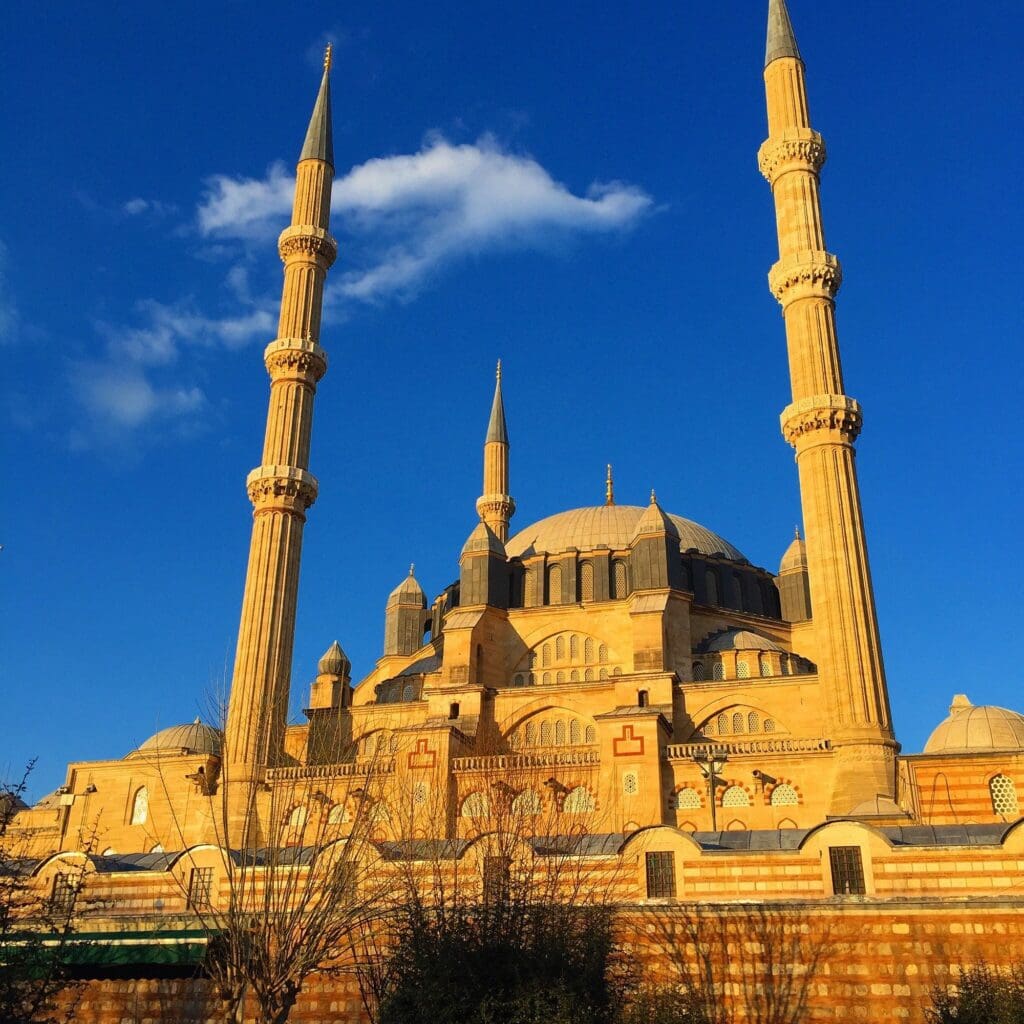
One of the mosque’s defining features is its spacious courtyard. The courtyard, almost as large as the mosque itself, emphasizes community. It serves as a gathering space for worshippers, fostering unity and social connection.
The mosque is made primarily of cut stone and marble, testament to its sturdy construction. These materials, with their natural hues, add an understated elegance to the building’s exterior. This choice reflects the economic and cultural might of the Ottoman Empire.
Inside the mosque, light plays a central role. The prayer hall is illuminated by 249 windows, ingeniously placed. This creates an ethereal ambiance, bathing worshippers in soft, divine light throughout the day.
Supporting the immense dome are eight robust pillars. These pillars are not just functional; they embody architectural beauty. Their presence allows for a vast, open interior which feels both airy and serene.
Symmetry is a hallmark of the mosque’s design. The precision in its layout is both visually appealing and symbolic. It mirrors the Islamic notion of balance and harmony, representing divine order.
The mosque also features a series of smaller domes surrounding the main dome. These domes enhance the structure’s aesthetic and functional elements. Their placement aids in distributing the weight evenly across the building.
The mosque’s fountain, located in the courtyard, is another noteworthy feature. It serves a practical purpose for ablutions but also adds tranquility. The sound of flowing water enhances the peaceful atmosphere.
Overall, the Selimiye Mosque stands as a symbol of architectural innovation and religious devotion. Its design integrates functionality with aesthetics, reflecting a harmonious blend of earthly and heavenly elements.
The Dome: A Symbol of Heaven
The grand dome of Selimiye Mosque is an architectural marvel. Its sheer size and perfect symmetry captivate all who behold it. Standing 43.28 meters high, it is a focal point that symbolizes the heavens above.
Mimar Sinan engineered the dome with unparalleled skill. With a diameter of 31.25 meters, it pushes the boundaries of engineering of its era. It achieves a seamless blend of form and function, a hallmark of Sinan’s genius.
The dome rests on an octagonal support structure, a feat of engineering mastery. This design allows for a wide, open interior space without compromising stability. It creates an awe-inspiring effect for worshippers within.
The dome’s interior is adorned with intricate patterns. These motifs, richly decorated, engage the eye and elevate the spirit. They represent the infinite nature of the divine, drawing worshippers closer to God.
Natural light streams through the dome’s windows, creating a celestial atmosphere. This illumination transforms the prayer hall into a vibrant, sacred space. It exemplifies the fusion of architecture and spirituality.
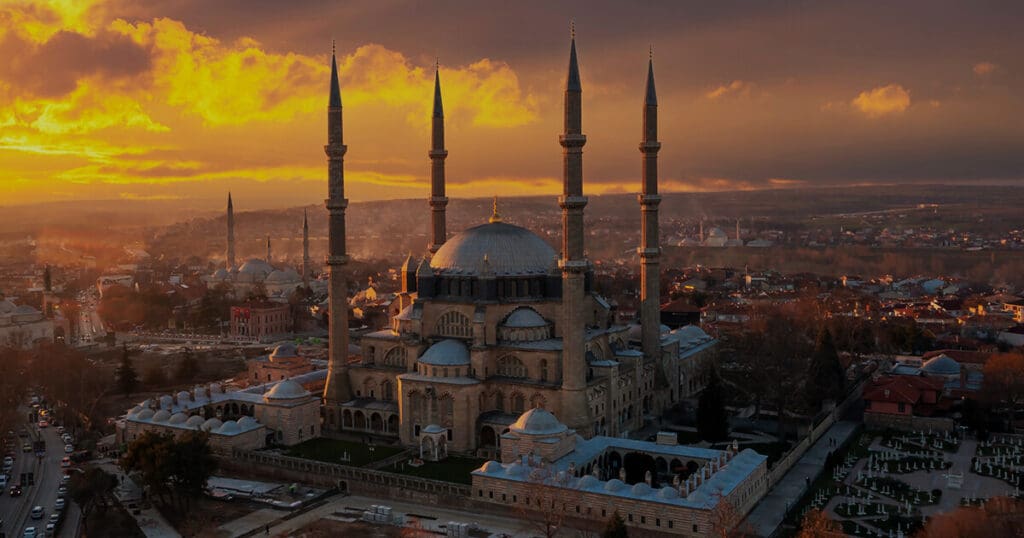
The Minarets: Reaching for the Sky
Four towering minarets frame the Selimiye Mosque, piercing the sky. Each minaret stands 83 meters tall, among the tallest globally. Their slender form embodies architectural elegance and structural prowess.
The minarets are not merely decorative; they serve a vital function. From their balconies, the call to prayer echoes across Edirne. They connect the faithful to their spiritual obligations with grace and authority.
Crafted with intricate stone carvings, the minarets display remarkable artistry. Their detailed design adds a layer of beauty to the mosque’s silhouette. These embellishments showcase the Ottoman Empire’s commitment to artistry.
The positioning of the minarets around the mosque is symmetrical and intentional. This design enhances the mosque’s balanced appearance. It aligns with the Islamic emphasis on symmetry and order.
The minarets invite the gaze upward, inspiring contemplation. They symbolize humanity’s connection to the divine, reaching towards the heavens. This symbolism is both powerful and profound, embodying spiritual aspiration.
Interior Wonders: Iznik Tiles and Calligraphy
Step inside the Selimiye Mosque, and a feast for the senses awaits. The interior is a dazzling showcase of Iznik tiles and exquisite calligraphy. Together, they create an environment of spiritual and aesthetic richness.
Iznik tiles, known for their vivid colors and floral patterns, adorn the walls. These tiles bear traditional Islamic motifs, reflecting unity and beauty. They testify to the skilled artisanship of Ottoman tile makers.
The vibrant hues of the tiles bring the interior to life. Blues, reds, and greens intertwine, creating a kaleidoscope of colors. This vibrant palette enhances the mosque’s sense of peace and creativity.
Calligraphy lines the walls, capturing the viewer with fluid strokes. Famous Ottoman calligraphers contributed their artistry, penning Quranic verses. This calligraphy elevates the words of the Quran to visual art.
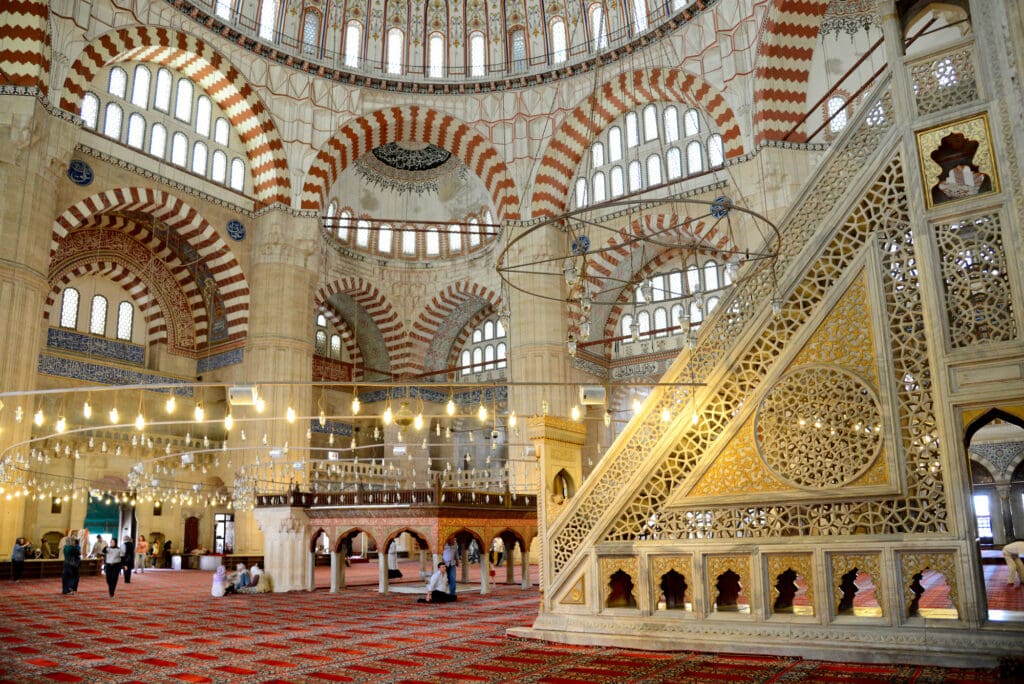
The use of calligraphy serves a dual purpose. It not only decorates but also invites reflection and devotion. Worshippers are drawn into a deeper connection with their faith through these inscriptions.
The mosque’s mihrab and minbar are masterpieces of craftsmanship. They are adorned with marble and finely detailed woodwork. These elements add a tangible sense of history and tradition to the space.
The interior of the Selimiye Mosque offers more than beauty. It provides a space where art and spirituality merge. Here, worshippers can find an oasis of calm, a place to connect with the divine amidst exquisite artistry.
The Mosque’s Social Complex: A Hub of Ottoman Life
The Selimiye Mosque isn’t just a place of worship. It also served as a vibrant hub of social and cultural life. Its complex housed essential institutions like a madrasa, an arasta, and a hospital.
Within the mosque’s boundaries, the social complex played a vital role. It bridged spiritual life with education, commerce, and healthcare. This ensured the mosque was a focal point of community life in Edirne.
The mosque’s complex reflected Sultan Selim II’s vision for a thriving society. He aimed to foster learning and community welfare alongside devotion. This vision made the mosque a nucleus of Ottoman life.
Mimar Sinan designed the complex to cater to the diverse needs of its community. Each component was carefully positioned to enhance its functionality. The design ensured ease of access while maintaining architectural harmony.

Over time, the social complex evolved to serve its community better. It became a central gathering point in Edirne, offering support to all. The integration of these facilities reflected the Ottoman emphasis on communal welfare.
The mosque’s design emphasized the unity of life’s various facets. From prayer to learning, shopping to healing, all activities found a place here. This holistic approach enriched the community’s experience, making it a cherished social center.
The Madrasa: A Center for Learning
The madrasa at Selimiye Mosque was more than an educational facility. It played a crucial role in fostering Islamic scholarship. As a hub for learning, it attracted students and scholars from afar.
Here, classical Islamic texts were studied and debated. The curriculum included theology, law, and the sciences. This breadth of study prepared students for leadership and scholarly roles.
The madrasa’s presence underscored the mosque’s status as a center of knowledge. It highlighted the Ottoman commitment to education as a pillar of society. This tradition of learning continues to inspire in contemporary times.
The Arasta: A Market for the People
The arasta, or market, added a vibrant dimension to the complex. It catered to everyday needs while supporting the mosque’s upkeep. This bustling marketplace was integral to the mosque’s economic sustainability.
Here, merchants sold various goods, from textiles to spices. The exchange of goods also facilitated cultural and social exchanges. This marketplace was a melting pot where different communities interacted.
The arasta ensured that the mosque complex remained a self-sustaining entity. Revenue from the market was vital for maintaining the mosque and its associated facilities. It stood as a testament to the Ottoman approach to community economics.
The Hospital: Caring for the Community
The mosque’s hospital served as a beacon of compassion. It provided medical care to Edirne’s diverse population. This facility was crucial in a time when access to healthcare was limited.
Patients of all backgrounds received treatment here, regardless of status. The hospital embodied the Islamic principle of caring for all. Medical services offered a blend of traditional and progressive treatments.
This institution not only healed but also advanced medical knowledge. It contributed to the community’s well-being and embodied charitable values. The hospital ensured that the mosque complex was a place of holistic care and compassion.
Selimiye Mosque as a UNESCO World Heritage Site
Selimiye Mosque gained UNESCO World Heritage status in 2011. This recognition highlights its global cultural and architectural value. It stands as an outstanding example of Islamic art and architecture.
The mosque’s inclusion underscores its historical and cultural significance. UNESCO’s designation recognizes Selimiye’s influence beyond its physical structure. It marks the mosque’s role in shaping architectural practices worldwide.
The UNESCO status helps ensure the mosque’s preservation for future generations. This includes maintaining its structural integrity and protecting its intricate artistry. It confirms the mosque’s importance as a cultural treasure.
Being part of the World Heritage list raises the mosque’s profile internationally. This attracts scholars, tourists, and art lovers from across the globe. It also emphasizes the mosque’s continued relevance and enduring legacy.
The Influence of Selimiye Mosque on Ottoman Architecture
The Selimiye Mosque stands as a pinnacle of Ottoman architecture. Mimar Sinan, the mosque’s architect, set new standards with its design. His work influenced the trajectory of Ottoman mosque design.
Many later mosques draw inspiration from Selimiye’s harmonious proportions. The mosque exemplifies a perfect blend of form and function. Its aesthetic balance and grandeur became a blueprint for future architects.
The mosque’s main dome is a signature element in Sinan’s design. Its vastness inspired architects to pursue ambitious structures. This inspired innovations in dome construction across the Ottoman Empire.
Selimiye’s combination of Islamic and Byzantine elements created a hybrid style. This stylistic blend became a hallmark of Ottoman architecture. It showcased a harmonious integration of diverse cultural influences.
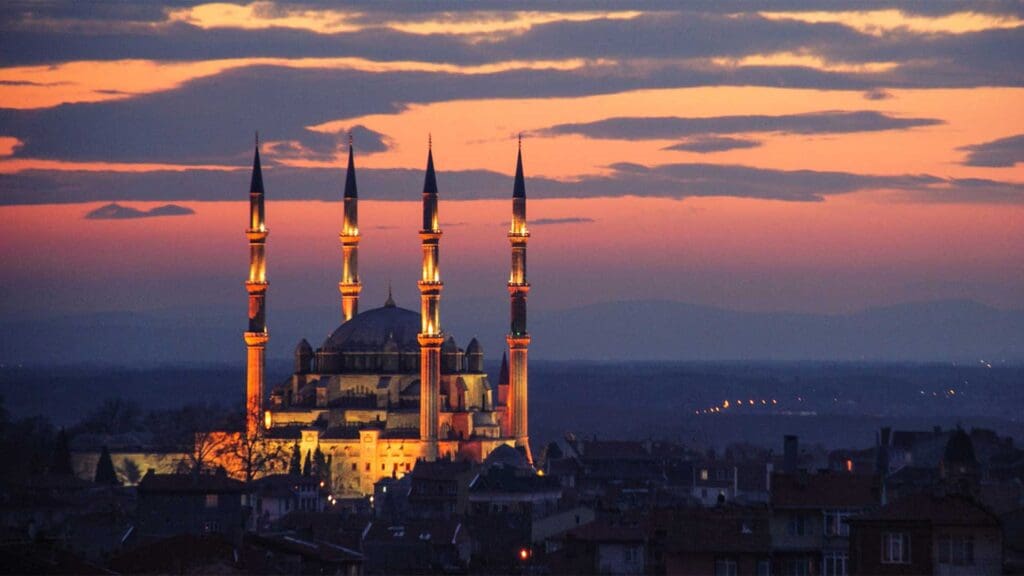
The mosque’s acoustics set a benchmark for auditory design. Its architecture ensured every corner echoed the imam’s voice clearly. This acoustical achievement became a standard in mosque designs thereafter.
In essence, Selimiye Mosque shaped architectural thought and practice. It left an enduring legacy on the Ottoman architectural landscape. Its impact extended far beyond its walls, influencing generations of builders.
Visiting Selimiye Mosque: A Traveler’s Guide
Edirne, where the majestic Selimiye Mosque stands, is a city steeped in history. Visiting this mosque offers more than just a journey into Islamic architecture. It provides a deep dive into the heart of the Ottoman Empire’s former capital.
As you approach, the mosque’s grandeur is immediately evident. The towering minarets and expansive dome dominate the skyline. This visual experience is a prelude to the wonders within.
Once inside, the intricate Iznik tiles capture your attention. Each tile tells a story, reflecting the skilled craftsmanship of the past. Wander through the prayer hall, and you’ll be enveloped in a sense of peace.
The mosque is not just a place of worship but a living museum. It offers insights into Ottoman religious and social life. The stories of its creation enrich your understanding of its significance.
Guided tours are available, providing a deeper appreciation of the mosque’s features. Experienced guides share fascinating details about its architecture and history. This context transforms your visit into a memorable learning experience.
For those who wish to explore further, the mosque complex holds additional treasures. The arasta and madrasa still reflect the vibrancy of their times. Each component of Selimiye contributes to its narrative as an enduring cultural beacon.
Best Times to Visit and Cultural Etiquette
When planning your visit, consider coming in the spring or autumn. These seasons offer pleasant weather, enhancing your experience. The beauty of the mosque and its surroundings is accentuated by the soft seasonal light.
Respect the local culture and traditions during your visit. Modest attire is advisable, as it aligns with the mosque’s sanctity. Men and women should cover their heads as a sign of respect.
Remember that Selimiye is an active place of worship. Visiting outside prayer times allows for quieter exploration. This timing ensures a respectful and unhurried experience within the sacred space.
Nearby Attractions and Accommodations
Edirne is home to other significant historical sites worth exploring. The Old Mosque and the Üç Şerefeli Mosque offer more architectural delights. Each site provides a unique glimpse into the city’s rich past.
For a taste of local culture, stroll through Edirne’s bustling bazaars. Here, traditional Turkish crafts and foods are on vibrant display. Visitors can savor local delicacies while engaging with the warm community.
Accommodation options in Edirne cater to diverse preferences. From charming guesthouses to luxurious hotels, choices abound. Staying in the city center allows easy access to the main attractions, enhancing your travel experience.
Conclusion: The Enduring Legacy of Selimiye Mosque
Selimiye Mosque stands as a testament to the zenith of Ottoman architecture. Its stunning design and cultural significance continue to captivate visitors. This architectural marvel has transcended time, marking an era of artistic brilliance.
The mosque is not just a historical landmark but a living legacy. Its influence extends beyond Turkey’s borders, impacting global architectural styles. The harmony and balance evident in its design inspire architects worldwide.
For centuries, Selimiye has been a beacon of Islamic art and scholarship. It embodies the spirit of innovation and devotion seen in Mimar Sinan’s work. The mosque’s enduring appeal lies in its perfect blend of beauty and spirituality.
Preservation efforts ensure that Selimiye Mosque remains for future generations. As a UNESCO World Heritage Site, it represents global cultural heritage. Each visit deepens appreciation for its artistry and the rich history it represents.
FAQs
1. Where is Grand Selimiye Mosque located?
Selimiye Mosque is located in Edirne, a city in northwestern Turkey near the Greek and Bulgarian borders.
2. Who built the Selimiye Mosque?
It was designed and built by the famous Ottoman architect Mimar Sinan in the 16th century.
3. When was Selimiye Mosque built?
Construction began in 1568 and was completed in 1575 during the reign of Sultan Selim II.
4. Is Selimiye Mosque a UNESCO World Heritage Site?
Yes, it was added to the UNESCO World Heritage List in 2011 for its outstanding architectural significance.
5. What is special about Selimiye Mosque?
Its massive dome, four slender minarets, and harmonious proportions make it a masterpiece of Islamic architecture.
6. Can tourists visit the mosque?
Yes, Selimiye Mosque is open to visitors. Non-Muslim tourists are welcome outside of prayer times.
7. Is there an entrance fee?
No, entry to the mosque is free, but donations for maintenance are appreciated.
8. What should visitors wear?
Modest clothing is required. Women are advised to cover their hair, and both men and women should cover shoulders and knees.
9. Are guided tours available?
Yes, guided tours are often available on-site or can be arranged through local travel agencies.
10. What are the mosque’s visiting hours?
It is generally open from early morning until late evening, except during prayer times when access is limited.

